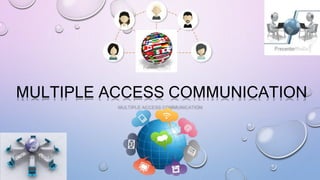
Multiple access communication
- 2. CONTENTS TO DISCUSSED • INTRODUCTION • HISTORY • MULTIPLE ACCESS TECHNIQUES • FDMA • TDMA • CDMA • SDMA • COMPARISON OF MULTIPLE ACCESS COMMUNICATION
- 3. INTRODUCTION Multiple access schemes allow many users to share a finite amount of radio spectrum in efficient manner As the spectrum is limited, so the sharing is required to increase the capacity of cell or over a geographical area by allowing the available bandwidth to be used at the same time by different users. Multiple Access communication
- 4. HISTORY WIRELESS COMMUNICATION : Wireless communications is a type of data communication that is performed and delivered wirelessly In 1894 Guglielmo Marconi began developing a wireless telegraph (first transatlantic wireless messages) system using radio waves Later wireless applications, including broadcasting (both audio and video), radar, and mobile telephony came into existence Alexander Graham Bell Made a first Wireless Phone That Ran on Sunshine Marconi wireless telegraph
- 5. MULTIPLE ACCESS TECHNIQUES KINDS OF MULTIPLE ACCESS TECHNIQUES
- 6. FREQUENDY DIVISON MULTIPLE ACCESS This was the initial multiple-access technique for cellular systems in which each individual user is assigned a pair of frequencies while making or receiving a call Applications of FDMA FDMA is used variety of applications such as telephone systems, radio systems, TV Advantages of FDMA 1.Simple to implement 2.Efficient with small base population Disadvantages of FDMA 1.Network and spectrum planning are time consuming 2.Channels are dedicated to single user
- 7. TIME DIVISON MULTIPLE ACCESS In digital systems, continuous transmission is not required because users do not use the allotted bandwidth all the time. In such cases, TDMA is a complimentary access technique to FDMA. Global Systems for Mobile communications (GSM) uses the TDMA technique. In TDMA, the entire bandwidth is available to the user but only for a finite period of time. In most cases the available bandwidth is divided into fewer channels compared to FDMA and the users are allotted time slots during which they have the entire channel bandwidth at their disposal Applications of TDMA TDMA is used variety of applications such as 2G cellular system,GSM Advantages of TDMA 1. TDMA can easily adapt to transmission of data as well as voice communication 2.Ability to carry 64 kbps to 120 Mbps of data rates 3.Most cost effective technology to convert an analog system to digital. Disadvantages of TDMA 1.Dropped calls are possible 2.Higher costs due greater equipment
- 8. CODE DIVISON MULTIPLE ACCESS CDMA is a form of multiplexing, which allows numerous signals to occupy a single transmission channel, optimizing the use of available bandwidth. The technology is used in ultra-high-frequency (UHF) cellular telephone systems in the 800-MHz and 1.9-GHz bands. Applications of CDMA CDMA is used variety of applications such as 3G cellular system,LTE,Satellite communication, Data security, GPS Advantages of CDMA 1.Better signal quality 2.High data rates 3.Impossible for hackers to decipher the code sent. Disadvantages of CDMA 1. Self-jamming(if sync not done b/w users) 2. As the number of users increases, the overall quality of service decreases
- 9. SPACE/BEAM DIVISON MULTIPLE ACCESS SDMA serves different users by using spot beam (A spot beam, in telecommunications parlance, is a satellite signal that is specially concentrated in power (i.e. sent by a high-gain antenna) so that it will cover only a limited geographic area on Earth) antenna,sectorized antennas can be thought as SDMA Applications of SDMA OPTOELECTRONICS, Satellite communication Advantages of SDMA 1.Increses channel capacity and transmission quality 2.High data rates Tb/sec throughput 3.Purely optical signal path Disadvantages of SDMA 1. Interfacing problem
- 11. REFERENCES 1. T. S. Rappaport, Wireless Communications: Principles and Practice, 2nd ed. Singapore: Pearson Education, Inc., 2002. 2. K. Feher, Wireless Digital Communications: Modulation and Spread Spectrum Applications. Upper Saddle River, NJ: Prentice Hall, 1995. 3. J. G. Proakis, Digital Communications, 4th ed. NY: McGraw Hill, 2000. 4. G. R. Cooper and C. D. McGillem, Modern Communications and Spread Spectrum, NY: McGraw Hill, 1986
- 12. Presented by MADUGULA SAIKUMAR 3rd year, ECE-’B’ Sec. 15A51A0495